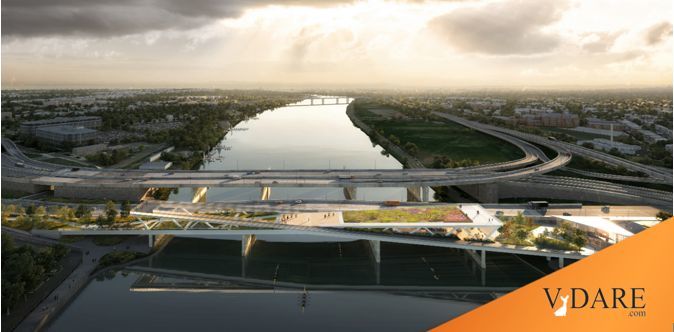


By Steve Sailer
08/10/2022
Earlier today, I posted an op-ed written by a Boston city planner and climate change activist who advocates for bicycles to reduce climate emissions. She takes a trip to her bicycle mecca, Amsterdam, and meets with city planners to find out how they’ve made their city so bike-friendly. But slowly, the horrifying truth dawns on her: the Dutch bureaucrats build fast, big, cheaply, and beautifully by focusing on the greatest good for the greatest number (i.e., Dutchmen) rather than on Centering the Marginalized like American city planners have been trained to do, which is a big reason few things get built in America.

Readers have pointed out yesterday’s New York Times article about how Who? Whom? thinking has halted any progress on turning an abandoned bridge across the Anacostia River near the U.S. Capitol into a park, but that’s a good thing because urban planners have been busy for 11 years trying to figure out how to prevent their planned park from causing gentrification.
Can Anacostia Build a Bridge Without Displacing Its People?
A decade in the works, the 11th Street Bridge Park in Washington, D.C., has yet to be built. But it could be a model for how to create public space while lessening the effects of gentrification.
By Megan Kimble
A new bridge for cars was built, but there are some disused piers from the old bridge still in the river. What if they they built a new bridge over them and made it a park? It would be kind of like the wildly popular High Line footpath along a disused elevated rail line on the west side of Manhattan. People would love it!
But what if white people loved it so much that they would want to move to the black slum of Anacostia and bring their Magic Dirt with them, oppressing blacks by taking away their natural right to live practically in the shadow of the U.S. Capitol building on the cheap (due to all the Tragic Dirt)?
By 2015, half of Washington’s Black population lived east of the river, where decades of disinvestment and racially restrictive redlining had depressed property values, concentrated poverty and left residents struggling to access basic services. …
Mr. Bey felt protective of his neighbors, worried that people who had lived in the area for decades would be priced out just as the neighborhood was beginning to flourish. “That seems like a system error,” Mr. Bey told me. “Why do we have to move out for everything to succeed and be beautiful?” …
The same question occupied Scott Kratz, the director of the 11th Street Bridge Park, for the better part of a decade. Mr. Kratz moved to Washington in 2006 with his wife and bought a house in Capitol Hill, four blocks from the Anacostia River.
… “So the biggest lesson we talk about with new projects is to think really carefully about who’s benefiting from that value.”
When Mr. Kratz set about building a bridge park, he was captivated by the idea of restitching Washington across the river that had long been an economic and racial divide. But he was from elsewhere, part of the wave of newcomers that had reshaped the city. Longtime residents and Ward 8 leaders pressed him to think bigger, beyond the footprint of the bridge itself.
… People in Ward 8 wanted this project, as small as it was, to be different. They wanted it to enrich the Black community that was already there, not accelerate an influx of white people. They wanted the value created by the bridge park to be invested in their neighborhoods. They wanted to own their own homes. They wanted well-paid jobs. They wanted art and music — and artists and musicians as neighbors. They wanted fresh food and safe streets.
It was a lot to ask of a bridge. But Mr. Kratz quickly learned that he couldn’t just build a bridge and ignore the needs of the community that contained it.
The bridge park has yet to be built. Walk down to the waterfront and all you see are those three old piers jutting out of the Anacostia River. But, in another sense, it does exist.
In the sense that Mr. Kratz has been paid for the last 8 years to struggle with how to square the circle of building something nice without it benefiting white people.
A physical landscape — homes, gardens, classrooms — has arisen out of the promise of a park. Over the past decade, Mr. Kratz and many others have tried to build this park differently, grappling at every step with the question that had so troubled Mr. Bey: Whom would it be for?

Note: Construction projects never wind up looking like they do in their renderings at sunset.
Like Stalin said: Who? Whom?
But from the beginning, this destination represented a threat to the existing neighborhood.
After OMA and Olin’s winning entry was published, Mr. Long said, real estate agents started using the rendering in home listings, touting proximity to the future bridge park. …
By 2014, Mr. Kratz had quit his job at the museum and joined the staff of a longtime Ward 8 nonprofit called, fittingly, Building Bridges Across the River as the director of the still-inchoate 11th Street Bridge Park. …
The park’s budget is roughly $177 million, with $45 million from the city. By the time it breaks ground in 2024, some $85 million of that will have already been spent on affordable housing, job training and community empowerment.
I.e., paying off community organizers has almost doubled the price tag. They are a big reason why we can’t have nice things.